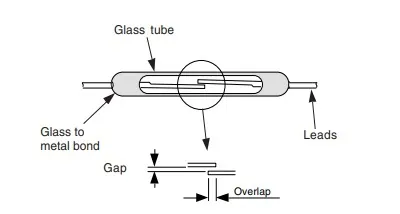21 Interview questions and answers on reed switches
What is a reed switch ?

A reed switch is an electrical switch that is activated by a magnetic field.
How does a reed switch work?

A reed switch consists of two ferromagnetic contacts that are normally open. When a magnetic field is applied, the contacts come together, closing the switch and allowing current to flow through it.
What is the working principle of reed switch?
A reed switch is an electrical switch that is operated by a magnetic field. It consists of two thin metal strips, usually made of a nickel-iron alloy, which are hermetically sealed inside a glass envelope.
When a magnetic field is applied to the switch, the metal strips inside the glass envelope become magnetized and are attracted to each other, closing the switch contacts. When the magnetic field is removed, the strips lose their magnetization and the switch contacts open again.
The reed switch is normally used as a sensor or detector, and is often used in applications such as security systems, door and window sensors, and proximity switches. The switch can be easily activated by a magnet, and it is very reliable and durable, making it suitable for use in harsh environments.
What are the two parts of a reed switch?
The two parts of a reed switch are the ferromagnetic contacts and the glass tube that houses them.
What are the advantages of using a reed switch?
The advantages of using a reed switch include its small size, low power consumption, and ability to switch both AC and DC currents.
What are some common applications of reed switch?
Some common applications of reed switches include security systems, proximity sensors, flow meters, level sensors, automotive applications, and medical devices.
Can reed switch be used with both AC and DC currents?
Yes, reed switches can be used with both AC and DC currents.
How are reed switches activated?
Reed switches are activated by a magnetic field.
What is the life expectancy of a reed switch?
The life expectancy of a reed switch is typically around 10 million cycles.
What are the two types of reed switches?
The two types of reed switch are normally open (NO) and normally closed (NC).
Can reed switches be used in harsh environments?
Yes, reed switches are not affected by dust, dirt, or other contaminants, which makes them suitable for use in harsh environments.
How are reed switches installed?
It can be installed using screws, adhesive, or clips.
What is the maximum switching frequency of a reed switch?
The maximum switching frequency of a reed switch is typically around 500 Hz.
What is the minimum operating temperature of a reed switch?
The minimum operating temperature of a reed switch is typically around -40°C.
What is the maximum operating temperature of a reed switch?
The maximum operating temperature of a reed switch is typically around 125°C.
What is the minimum operating voltage of a reed switch?
The minimum operating voltage of a reed switch is typically around 50 mV.
What is the maximum operating voltage of a reed switch?
The maximum operating voltage of a reed switch is typically around 1 kV.
How are reed switches tested?
It can be tested using a multimeter or an oscilloscope.
Can reed switch be used in high-speed applications?
No, reed switches are not suitable for high-speed applications due to their limited switching frequency.
What is the typical response time of a reed switch?
The typical response time of a reed switch is around 1 ms.
Can reed switch be used in explosive environments?
Yes, reed switches can be used in explosive environments if they are certified for use in those environments.
You may also like
